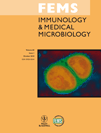Streptococcus pneumoniae modulates the respiratory burst response in human neutrophils
Editor: Richard Marconi
Abstract
The gram-positive pathogen Streptococcus pneumoniae is the most common cause of community-acquired pneumonia and is responsible for high morbidity and mortality worldwide. A major feature of pneumococcal pneumonia is an abundant neutrophil infiltration. In this work we observed that the R6 nonencapsulated S. pneumoniae strain induced a higher oxidative burst in neutrophils compared with its capsulated progenitor D39, by triggering neutrophil NADPH oxidase to produce more reactive oxygen intermediates (ROI) and by interfering with the neutrophil kinase signalling pathway. In addition, we evaluated the possibility that the capsule, lacking in R6 but present in D39, could modulate the S. pneumoniae-induced neutrophil respiratory burst. In this respect, three knock-out isogenic mutants (D39ΔCPS2E, D39ΔCPS-R6 and R6ΔCPS-R6) that were unable to synthesize the capsule, were tested for their capability of inducing the release of neutrophil-ROIs. The results indicate that the mutants behaved similarly to their wild-type parental strains in enhancing respiratory burst activity, suggesting that the capsule itself is not directly involved in modulating the neutrophil oxidative burst induced by S. pneumoniae, but that other genetic differences between D39 and R6 present elsewhere in the genome could be responsible for these mechanisms.




